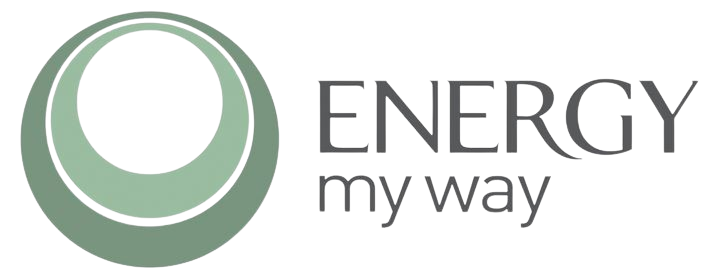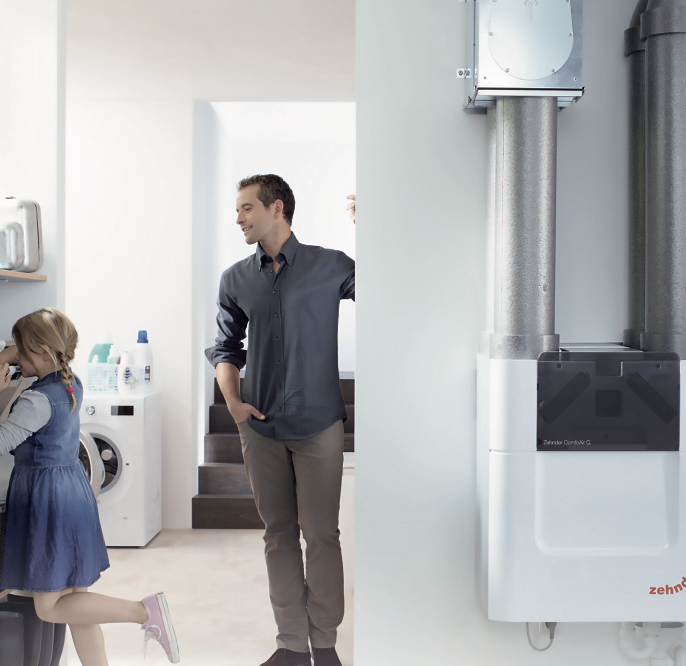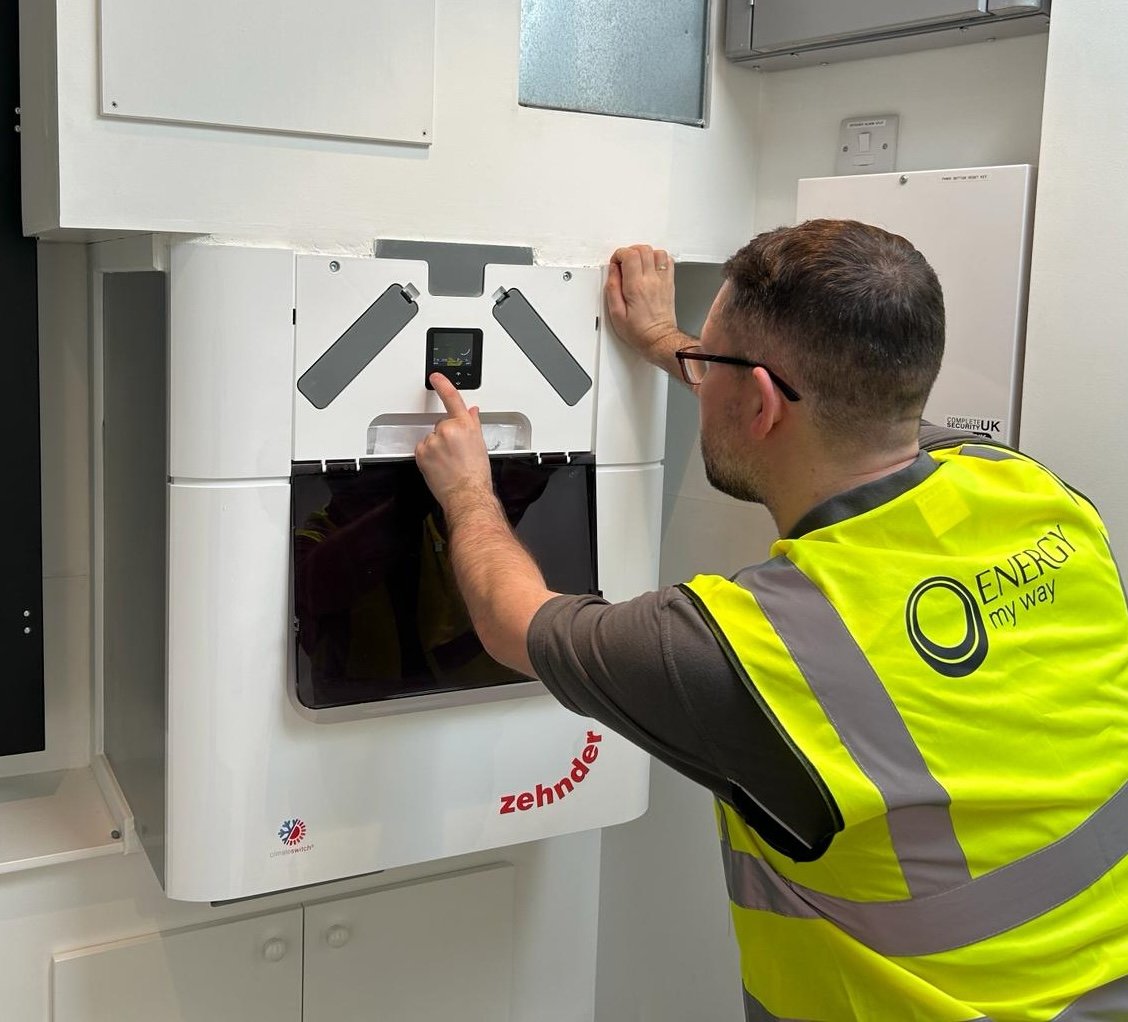
Mechanical Ventilation Installation
“EnergyMyWay are one of Zehnder’s leading MVHR installation Service Partners, with the experience and knowledge that underpins a first class service.”
Jason Bennet, Zehnder UK (Submitted by email)
With modern homes being constructed to stricter air-tight standards, proper ventilation has become essential. Mechanical Ventilation with Heat Recovery (MVHR) systems are designed to address this need by providing a balance of fresh air supply and extracting stale air, while simultaneously recovering heat from outgoing air.
This process not only enhances energy efficiency but also improves indoor air quality, ensuring a comfortable and healthy living environment.
Our service offers a complete solution, including the design, supply, installation, and maintenance of MVHR systems, tailored to meet the unique requirements of each property.
How Does an MVHR System Work?
MVHR systems function by continuously supplying fresh air to living spaces, while extracting stale air from moisture-heavy areas such as kitchens and bathrooms. The system recovers heat from the extracted air, transferring it to the incoming fresh air, which can significantly reduce heating costs.
This efficient process helps maintain a balanced, healthy indoor climate, particularly in tightly sealed homes where traditional ventilation methods may fall short. The key benefits of MVHR include improved indoor air quality, reduced energy consumption, balanced humidity, and better overall climate control.
At the heart of the system is a central unit, featuring a fan and heat exchanger, typically installed in a loft or utility space – two external air ducts draw fresh air in and expel stale air out. A supply and extract manifold channels the air through individual ducts, each leading to a discrete ceiling vent in different rooms. This means living areas receive fresh air, while kitchens, bathrooms, and utility rooms have vents that continuously extract stale air.
“Your professionalism, quality of work and genuine care about what you do has made the whole process easy from start to finish. I would be more than happy, and fully intend to recommend EnergyMyWay to anyone who is considering renewable energy for their property."
Andrew Brown, customer (Post-installation questionnaire)
Using MVHR Systems for Cooling Your Home
One of the challenges with modern homes is that high insulation levels mean it can be a challenge to keep them cool in hot weather. MVHR systems have a summer-bypass, which means extracted air bypasses a heat exchanger to remove hot air from the house. Mechanical cooling can be added to your system to cool incoming air and reduce the incoming air temperature in the home. This is not air conditioning – it’s comfort cooling. However, we’ve found clients enjoy the benefits of this function during hot summers.
Planning Your Ventilation Strategy
A well-designed ventilation system is crucial for any new home and should be considered in the early stages of the design process. Including a ventilation strategy alongside other key services ensures it is effectively integrated into the building plans. This aspect should be discussed as part of the overall design phase.
Our in-house technical team carefully designs every MVHR system, which is then installed by our certified team of accredited professionals, ensuring improved heat efficiency and reduced energy consumption. For maximum durability, we use only high-quality metal and plastic components, with all ducting and silencers mechanically fastened and sealed at every joint to ensure reliability.
“We worked closely with EnergyMyWay over a about a year as we renovated our town house to become more green and reduce our dependency on fossil fuels and the grid. They installed Solar PV, Air Source Heat Pump, Mechanical Ventilation with Heat Recovery, and home automation systems. They were utterly professional throughout the process keeping us informed of progress, tasks that needed input from us, milestones coming up, etc. They responded in a timely manner via both email and telephone and several times popped over to help out in-person. We have recommended them to many friends and neighbours and remain in contact over 18 months on.”
James Wilkinson, 2021 customer (Google review)
Cost Savings of an MVHR System
Since your MVHR system pre-warms the incoming fresh air, it significantly reduces heat loss through ventilation. By efficiently retaining warmth within the home, the system can lead to approximately a 25% reduction in heating costs for the property.
This not only translates into substantial energy savings but also contributes to a more comfortable, healthier, and well-ventilated living environment, ensuring consistent air quality and temperature throughout the home. Additionally, the improved energy efficiency helps reduce your home's overall carbon footprint, making it an eco-friendly solution.
You Can Breathe Easy
In addition to controlling temperature, MVHR systems contribute to healthier indoor air by filtering out pollutants, allergens, and other harmful particles. This is particularly beneficial for individuals who suffer from allergies or asthma, as anti-allergy filters can be installed to reduce the presence of airborne irritants.
Bespoke Ventilation Systems
Our services include full design consultation to develop tailored ventilation solutions, expert installation of high-quality MVHR systems, and regular maintenance to ensure efficient operation. With our comprehensive approach, we are committed to improving your home’s air quality, energy efficiency, and comfort. Contact us today to learn more about how mechanical ventilation can enhance your home and to arrange a free consultation.
MVHR systems are installed by our EnergyMyWay installation team of directly employed operatives, all of whom are qualified under the BPEC Domestic Ventilation training scheme.
Contact us today to discuss your ventilation project and to experience our full design, supply, installation, service.
You can give us a call at 01865 856930, send us an email at info@energymyway.co.uk,
or fill in the form by clicking the button below.
Learn more by visiting our Resources section or read some of our Case Studies.








